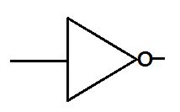
When an input signal \[1\] is applied to a NOT gate, its output is:
A) \[1\]
B) \[0\]
C) Either \[0\] or \[1\]
D) Both \[0\] and \[1\]
Answer
216.3k+ views
Hint: NOT gate is one of the basic logical gates. It can be remembered from the name itself that NOT implies getting the opposite output. Remember all the basic gates to avoid confusion.
Complete step by step solution:
The various basic logic gates used digital systems are as follows:
1. OR Gate
2. AND Gate
3. NOT Gate
4. XOR Gate
Below is the NOT gate.

OR GATE: In OR gate the output of an OR gate gives the state \[1\] , if one or more inputs attain the state \[1\] i.e. when any one input is \[1\] then the output will be one.
The Boolean expression of the OR gate is given as \[Y=A+B\], which is read as \[Y\] equals \[A\] ‘\[OR\] ’ \[B\].
AND GATE: In AND gate the output of an AND gate is \[1\] if and only if all the inputs are in state \[1\]. The Boolean expression of AND gate is \[Y=A.B\] which is read as Y equals A ‘AND’ B.
NOT GATE: In NOT gate the output of a NOT gate attains the state \[1\] if and only if the input does not attain the state \[1\] . The Boolean expression is \[Y=\overline{A}\] , read as Y equals NOT A.
Hence for input signal \[1\] the output will be \[0\].
Note: All basic gates must be remembered. NAND and XNOR gates are the logical gates which can be obtained using the basic OR, NOT and AND gate. Also the truth table can be easily constructed for each logical gate based on the above definitions. Truth tables make it easier to understand logical gates.
Complete step by step solution:
The various basic logic gates used digital systems are as follows:
1. OR Gate
2. AND Gate
3. NOT Gate
4. XOR Gate
Below is the NOT gate.

OR GATE: In OR gate the output of an OR gate gives the state \[1\] , if one or more inputs attain the state \[1\] i.e. when any one input is \[1\] then the output will be one.
The Boolean expression of the OR gate is given as \[Y=A+B\], which is read as \[Y\] equals \[A\] ‘\[OR\] ’ \[B\].
AND GATE: In AND gate the output of an AND gate is \[1\] if and only if all the inputs are in state \[1\]. The Boolean expression of AND gate is \[Y=A.B\] which is read as Y equals A ‘AND’ B.
NOT GATE: In NOT gate the output of a NOT gate attains the state \[1\] if and only if the input does not attain the state \[1\] . The Boolean expression is \[Y=\overline{A}\] , read as Y equals NOT A.
Hence for input signal \[1\] the output will be \[0\].
Note: All basic gates must be remembered. NAND and XNOR gates are the logical gates which can be obtained using the basic OR, NOT and AND gate. Also the truth table can be easily constructed for each logical gate based on the above definitions. Truth tables make it easier to understand logical gates.
Recently Updated Pages
JEE Atomic Structure and Chemical Bonding important Concepts and Tips

JEE Amino Acids and Peptides Important Concepts and Tips for Exam Preparation

Electricity and Magnetism Explained: Key Concepts & Applications

Chemical Properties of Hydrogen - Important Concepts for JEE Exam Preparation

JEE Energetics Important Concepts and Tips for Exam Preparation

JEE Isolation, Preparation and Properties of Non-metals Important Concepts and Tips for Exam Preparation

Trending doubts
JEE Main 2026: Application Form Open, Exam Dates, Syllabus, Eligibility & Question Papers

JEE Main Correction Window 2026 Session 1 Dates Announced - Edit Form Details, Dates and Link

Derivation of Equation of Trajectory Explained for Students

Hybridisation in Chemistry – Concept, Types & Applications

Understanding the Angle of Deviation in a Prism

Understanding Collisions: Types and Examples for Students

Other Pages
JEE Advanced Marks vs Ranks 2025: Understanding Category-wise Qualifying Marks and Previous Year Cut-offs

How to Convert a Galvanometer into an Ammeter or Voltmeter

Atomic Structure: Definition, Models, and Examples

Ideal and Non-Ideal Solutions Explained for Class 12 Chemistry

Degree of Dissociation: Meaning, Formula, Calculation & Uses

Understanding Electromagnetic Waves and Their Importance




